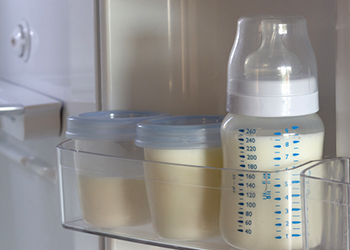Pediatrics / Young Lab / Projects / Donor Human Milk Study
Donor Human Milk May Not Always Be a Perfect Match
 Levels of zinc in pooled donor breastmilk do not meet the nutritional requirements of preterm infants and term newborns, according to a new study published in The Journal of Pediatrics by Bridget Young, Ph.D., and colleagues at the University of Colorado. The findings could have implications for the way donor milk is prepared in milk banks and how it is distributed to infants across the country.
Levels of zinc in pooled donor breastmilk do not meet the nutritional requirements of preterm infants and term newborns, according to a new study published in The Journal of Pediatrics by Bridget Young, Ph.D., and colleagues at the University of Colorado. The findings could have implications for the way donor milk is prepared in milk banks and how it is distributed to infants across the country.
The study analyzed the nutrient and caloric profile of 138 samples of donated human milk from The Mother’s Milk Bank in Colorado which is a member of the Human Milk Banking Association of North America (HMBANA). Researchers used a Miris Human Milk analyzer, the only FDA-approved product available for testing breast milk.
The results from the analysis also confirmed previous research finding lower caloric density in donor milk than expected.
“It’s important to note that the majority of donor milk is given to NICUs, which use fortifiers to ensure that premature babies receive the energy and nutrients they need,” said Young, a research assistant professor in the department of Pediatrics who co-founded the University of Rochester Human Milk and Lactation Research Consortium. “However, our study could change the ways donor milk is used in other settings, such as in nurseries or at home.”
Donor milk is increasingly provided to healthy term infants in the hospital, and is utilized by 18 percent of level 1 nurseries, according to a national study led by the Boston Medical Center. Parents are also increasingly purchasing donor milk privately or directly from milk banks. In those settings, milk is generally not fortified with extra nutrients or calories. This is one of the reasons HMBANA milk banks encourage parents’ close consultation with baby’s doctor if donor milk is used long term or as a large portion of intake.
Standardizing levels of zinc in donor milk is difficult, said Young, because the measurement process is time intensive. Zinc also dramatically decreases over the course of lactation and donor milk banks often face limited availability of milk donations when generating pools of donor milk. To address this challenge, Young’s study presented a new equation, based on the milk donor’s “post-partum time,” (or how long it has been since she delivered her baby and began nursing), that can predict the level of zinc in donor milk.
This equation could provide a method for standardization across milk banks.
“This is still an emerging field of research and sets the stage for further work on this topic,” said Young. “But, we’ve taken an important step by demonstrating new findings about the composition of donor milk and the way we might be able to optimize this important form of nutrition for infants.”
Read the article: Effect of Pooling Practices and Time Postpartum of Milk Donations on the Energy, Macronutrient, and Zinc Concentrations of Resultant Donor Human Milk Pools.